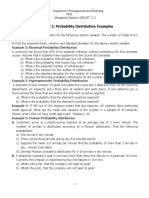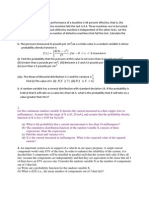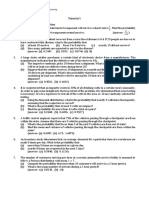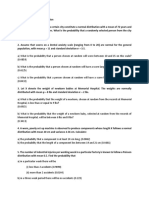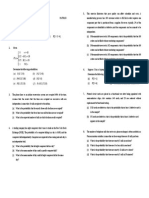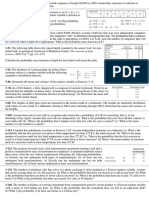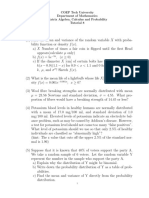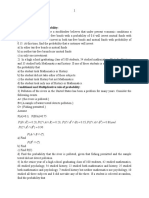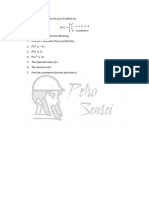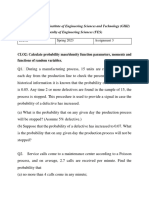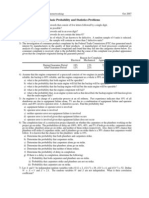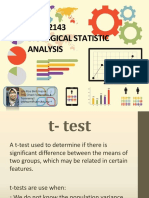Fdocslide - Us Problem Probability
Fdocslide - Us Problem Probability
Uploaded by
awesome112358Copyright:
Available Formats
Fdocslide - Us Problem Probability
Fdocslide - Us Problem Probability
Uploaded by
awesome112358Original Title
Copyright
Available Formats
Share this document
Did you find this document useful?
Is this content inappropriate?
Copyright:
Available Formats
Fdocslide - Us Problem Probability
Fdocslide - Us Problem Probability
Uploaded by
awesome112358Copyright:
Available Formats
PROBLEM SET 5 PROBABLITY
1. The analysis of shafts for a compressor is classified in terms of the machine tool that was used
for manufacturing the shafts and by conformance to specifications, as shown below.
Tool 1
surface finish
conforms
yes
no
roundness conforms
yes
no
645
10
23
19
yes
no
roundness conforms
yes
no
574
18
123
55
Tool 2
surface finish
conforms
(a) If a shaft is selected at random, what is the probability that the shaft conforms to surface
finish requirements or to roundness requirements or is from Tool 1?
(b) If a shaft is selected at random, what is the probability that the shaft conforms to surface
finish requirements or does not conform to roundness requirements or is from Tool 2?
(c) If a shaft is selected at random, what is the probability that the shaft conforms to both the
surface finish and roundness requirements or the shaft is from Tool 1?
(d) If a shaft is selected at random, what is the probability that the shaft conforms to surface
finish requirements or the shaft is from Tool 2?
(e) Given that a shaft selected at random conforms to surface finish requirements, what is the
probability that it is from Tool 1?
(f) Given that a shaft selected at random conforms to surface finish requirements, what is the
probability that it conforms to roundness requirements?
(g) Given that a shaft selected at random does not conform to surface finish requirements, what
is the probability that it is from Tool 1 and does not conform to roundness requirements?
2. A batch of 1000 containers for frozen orange juice contains 13 that are defective. Three containers
are selected at random, without replacement, from the batch.
(a) What is the probability that the third one selected is defective given that the first and the
second one selected were defective?
(b) What is the probability that the third one selected is defective given that the first one
selected was defective and the second one selected was okay?
(c) What is the probability that all the three were defective?
3. A batch of 100 injection-molded parts contains 12 that have suffered excessive shrinkage.
(a) If two parts are selected at random, and without replacement, what is the probability that
the second part selected is one with excessive linkage?
(b) If three parts are selected at random, and without replacement, what is the probability that
the third part selected is one with excessive linkage?
1
PROBLEM SET 5 PROBABLITY
4. Each of the following circuits operates only if there is a path of functioning devices from left to
right. The probability that each device functions is shown on the graph. Assume that devices
fail independently. What is the probability that the each of the circuits operates?
(b)
d
b
e
c
(a)
0.9
0.8
0.7
0.95
0.95
Figure 1
5. Customers are used to evaluate preliminary product designs. In the past, 96% of highly successful
products received good reviews, 66% of moderately successful products received good reviews,
and 12% of poor products received good reviews. In addition, 45% of products have been highly
successful, 37% have been moderately successful, and 18% have been poor products.
(a) What is the probability that a product attains a good review?
(b) If a new design attains a good review, what is the probability that it will be a highly
successful product?
(c) If a product does not attain a good review, what is the probability it will be a highly
successful product?
6. An inspector working for a company has a 98% chance of correctly identifying defective items
and a 1% chance of incorrectly classifying a good item as defective. The company has evidence
that its line produces 2% of nonconforming items.
(a) What is the probability that an item selected for inspection is classified as defective?
(b) If an item selected at random is classified as non-defective, what is the probability that it
is indeed good?
7. Let X be a random variable with probability distribution function given by
1
1
1
1
1
f (0) = , f (1) = , f (2) = , . . . f (9) = 10 , f (10) = 10
2
4
8
2
2
(a) Find the mean of X.
(b) Find the variance and standard deviation of X.
(c) What is P (3 X 8)?
PROBLEM SET 5 PROBABLITY
8. Suppose that X is a discrete uniform random variable on the integers 11 through 20. Determine
the mean, variance and the standard deviation of the random variable Y = 2X 5 and compare
to those of X.
9. Let X denotes the number of bits received in error in a digital communication channel, and
assume that X is a binomial random variable with p = 0.0014. If 1500 bits are transmitted,
determine the following.
(a) The probability that there is exactly one error received.
(b) The probability that no error is received.
(c) The probability that at least one error is received.
(d) The probability that not more than 3 errors are received.
(e) The mean and variance of X.
10. Because not all airline passengers show up for their reserved seat, an airline sells 325 tickets for
a flight that holds only 320 passengers. The probability that a passenger does not show up is
0.025, and the passengers behave independently.
(a) What is the probability that every passenger who shows up can take the flight?
(b) What is the probability that the flight departs with empty seats?
11. Suppose that the number of customers X that enter a cafe in twenty minutes is a Poisson random
variable, and the probability that no customer enter the cafe in an hour is 0.02.
(a) Find the probability distribution function of X.
(b) Find the mean and variance of the number of customers entering the cafe in twenty minutes
and in an hour.
(c) What is the probability that no customer enter the cafe in twenty minutes?
(d) What is the probability that there will be at least 3 customers entering the cafe in twenty
minutes?
12. The number of flaws in bolts of cloth in textile manufacturing is assumed to be Poisson distributed with a mean of 0.05 flaw per square meter.
(a) What is the probability that there are at least two flaws in 1 square meter of cloth?
(b) What is the probability that there are no flaw in 5 square meters of cloth?
(c) What is the probability that there are 3 flaws in 15 square meters of cloth?
(d) What is the largest possible area of cloth such that the probability that no flaw is found on
the area is larger than 0.5?
13. Suppose that X is a continuous random variable with probability density function
3 x
,
0 x 100
f (x) =
2000
(a) Find the cumulative distribution function of X.
(b) Find P (10 X 50).
(c) Find the mean, variance and standard deviation of X.
14. Let Z be a standard normal random variable. Find the following probabilities.
(a) P (Z < 1.32)
(b) P (Z > 1.32)
(c) P (Z < 1.32)
(d) P (Z > 1.32)
(e) P (0 < Z < 1.32)
(f) P (|Z| < 1.32)
(g) P (1 < Z < 3)
(h) P (1 < Z < 3)
PROBLEM SET 5 PROBABLITY
15. Let Z be a standard normal random variable. Determine the value of z that satisfies each of the
following.
(a) P (Z < z) = 0.9
(b) P (Z > z) = 0.4
(d) P (|Z| < z) = 0.8
(e) P (|Z| > z) = 0.05
(c) P (Z > z) = 0.6
(f) P (1.32 < Z < z) = 0.6
16. The compressive strength of samples of cement can be modeled by a normal distribution with
a mean of 7000 kilometers per square centimeter and a standard deviation of 180 kilograms per
square centimeter.
(a) What is the probability that a samples strength is less than 7200 kilograms per centimeter?
(b) What is the probability that a samples strength is between 6800 and 6900 kilograms per
centimeter?
(c) What is the probability that a samples strength is between 6950 and 7050 kilograms per
centimeter?
(d) What strength is exceeded by 98% of the samples?
17. The diameter of the dot produced by a printer is normally distributed with mean diameter 5mm
and standard deviation of 0.2mm.
(a) What is the probability that the diameter of a dot exceeds 5.5mm?
(b) What is the probability that a diameter is between 4.9mm and 5.1mm?
(c) What standard deviation of diameter is needed so that the probability in part (b) is 0.999?
18. The diameter of a shaft in an optical storage drive is normally distributed with mean cm and
standard deviation 0.001cm. The specifications on the shaft are 0.7 0.003cm. What proportion
of shafts conforms to specification if (a) = 0.7015 (b) = 0.7?
19. Suppose that X has an exponential distribution with = 1.2. Determine the following.
(a) The mean and standard deviation of X.
(b) P (X < 5)
(c) P (X > 5)
(d) P ( < X < + )
(e) P ( < X < )
(f) P ( < X < + )
(g) The value x such that P ( < X < x) = 0.2
(h) The value x such that P (x < X < ) = 0.2
20. The time between calls to a plumbing supply business is exponentially distributed with a mean
time between calls of 12 minutes.
(a) What is the probability that there are no calls within a 30-minute interval?
(b) What is the probability that at least one call arrives within a 10-minute interval?
(c) What is the probability that the first call arrives between 10 and 20 minutes after opening?
(d) Determine the length of an interval of time such that the probability of at least one call in
the interval is 0.95.
21. The time between arrival of electronic messages at your computer is exponentially distributed
with a mean of 1.5 hours.
(a) What is the probability that you do not receive a message during a 1.5-hour period?
(b) What is the probability that you do not receive a message during a 4 hour period?
(c) If you had not received a message during the last three hours, What is the probability that
you do not receive a message in the next 3 hours?
(d) What is the expected time between your second and third message?
PROBLEM SET 5 PROBABLITY
Answer:
1412
1444
1271
1425
655
(b)
(c)
(d)
(e)
1467
1467
1467
1467
1247
11
12
13 12 11
2. (a)
(b)
(c)
998
998
1000 999 998
12
12
3. (a)
(b)
100
100
4. (a) 0.9293
(b) (a + b + c ab ac bc + abc)(d + e de) + (f + g f g)hi
(a + b + c ab ac bc + abc)(d + e de)(f + g f g)hi
1. (a)
5. (a) 0.6978
(b) 0.6190
6. (a) 0.0294
(b) 0.9996
7. (a) 0.9990
(b)1.9795
8. X
Y
mean = 15.5,
mean = 26,
9. (a) 0.2571
10. (a) 0.9101
1219
1247
(g)
(c) 0.0596
(c) 0.1230
variance = 8.25
variance = 33
(b)0.1223
(f)
standard deviation = 2.8723
standard deviation = 5.7446
(c) 0.8777
(d) 0.8388
(e) 2.1, 2.0971
(b) 0.8234
n
, = 3.9120, n = 0, 1, 2, 3, . . .
n!
(b) In twenty minutes, mean=variance= 1.3040, in an hour, mean=variance= 3.9120
(c) 0.2714
(d) 0.1438
11. (a) f (n) = e
12. (a) 0.0012
(b) 0.7788
0,
x<0
3/2
x
13. (a) F (x) =
, 0 x 100
1000
1,
x > 100
14. (a) 0.9066
(e) 0.4066
15. (a) 1.28
(b) 0.0934
(f) 0.8132
(b) 0.25
(c) 0.25
(c) 0.0332
(c) 0.0934
(g) 0.1573
(d) 1.28
(b) 0.1542
(c) 0.2205
17. (a) 0.0062
(b) 0.3829
(c) 0.0304 mm
18. (a) 0.9332
(b) 0.9973
(b) 0.9975
(f) 0.8111
r
3
4800
(c) 60,
, 40
7
7
(b) 0.3219
16. (a) 0.8665
19. (a) 0.8333
(e) 0.5654
(d) 13.8629
(d) 0.9066
(h) 0.8400
(e) 1.96
(f) 0.51
(d) 6631 kilograms per centimeter
(c) 0.0025
(g) 1.4499
(d) 0.2457
(h) 0.4548
20. (a) 0.0821
(b) 0.5654
(c) 0.2457
(d) 35.9488 minutes
21. (a) 0.3679
(b) 0.0695
(c) 0.1353
(d) 1.5 hours
19
220
You might also like
- Assignment 3 - With Answers - Engineering Statistics - Spring 2020Document7 pagesAssignment 3 - With Answers - Engineering Statistics - Spring 2020Kareema BatoolNo ratings yet
- RSCH 121 Week 1 10Document20 pagesRSCH 121 Week 1 10Mark Allen Secondes80% (20)
- Problem ProbabilityDocument5 pagesProblem ProbabilityAthyab MuhithNo ratings yet
- Exercises 3 (Chapter 4) : Kkkq2024 Engineering StatisticsDocument4 pagesExercises 3 (Chapter 4) : Kkkq2024 Engineering StatisticsNavin KumarNo ratings yet
- Chapter 2: Probability Distribution ExamplesDocument4 pagesChapter 2: Probability Distribution ExamplesDawit MihiretNo ratings yet
- HND TestDocument2 pagesHND Testbright01No ratings yet
- Homework 2Document6 pagesHomework 2sirali940% (1)
- Tutorial 1 Discrete Probability Distribution: STA408: Statistics For Science and EngineeringDocument6 pagesTutorial 1 Discrete Probability Distribution: STA408: Statistics For Science and EngineeringArf ZizNo ratings yet
- Tutorial 1 - Probability DistributionDocument6 pagesTutorial 1 - Probability DistributionMohd MursyidNo ratings yet
- Exercise Probability Distribution QADocument3 pagesExercise Probability Distribution QAHafiz khalidNo ratings yet
- SheetsDocument16 pagesSheetsnorantharwat58No ratings yet
- Stats 2017, 2018 UnsolvedDocument12 pagesStats 2017, 2018 Unsolvedgkashish629No ratings yet
- Tutorial Ssce 2193 2017Document15 pagesTutorial Ssce 2193 2017karimov1924No ratings yet
- HW - Probability and StatisticsDocument9 pagesHW - Probability and Statisticshoangvy26052005No ratings yet
- Exercise3 - S2 2014Document2 pagesExercise3 - S2 2014Renukadevi Rpt100% (1)
- Sheet5ProbPower PDFDocument2 pagesSheet5ProbPower PDFpop100% (1)
- PSMOD Chapter 4 Probability Distribution-SolutionDocument5 pagesPSMOD Chapter 4 Probability Distribution-Solution陈安宁No ratings yet
- Estadistica Cap3,4Document2 pagesEstadistica Cap3,4Salome ValeriaNo ratings yet
- Tutorial 8Document2 pagesTutorial 8joshinihar19No ratings yet
- Assignment 4Document8 pagesAssignment 4Sania ShehzadNo ratings yet
- Jntu Ii-B.tech I-Sem Ro9 Reg Exam Question Papes Nov 2010Document45 pagesJntu Ii-B.tech I-Sem Ro9 Reg Exam Question Papes Nov 2010Shivajyothi KondaparthiNo ratings yet
- Cse QB Unit4Document17 pagesCse QB Unit4Akash GolwalkarNo ratings yet
- Assignment 3 - With Answers - Engineering Statistics - Spring 2020 PDFDocument7 pagesAssignment 3 - With Answers - Engineering Statistics - Spring 2020 PDFKareema BatoolNo ratings yet
- 9abs304-Probability StatisticsDocument5 pages9abs304-Probability StatisticsYCRNo ratings yet
- Statistics Sheet 4 PDFDocument3 pagesStatistics Sheet 4 PDFإبراهيم مرجاويNo ratings yet
- Tutorial List 1Document10 pagesTutorial List 1नेपाली नेवरि प्रसन्नNo ratings yet
- EndSemExam 2021-22Document3 pagesEndSemExam 2021-22SushrutNo ratings yet
- HIT2102 - 2023 - Tutorial 2Document5 pagesHIT2102 - 2023 - Tutorial 2wesleybvitira28No ratings yet
- Probability and StatisticsDocument8 pagesProbability and StatisticsSaiVenkatNo ratings yet
- 03 Probability DistributionDocument3 pages03 Probability DistributionThapaa Lila100% (1)
- SEHH1070 Tutorial Exercise 5 PDFDocument3 pagesSEHH1070 Tutorial Exercise 5 PDFLinus KwokNo ratings yet
- Probability & StatisticsDocument5 pagesProbability & StatisticsShareef KhanNo ratings yet
- Application AssisgnmentDocument4 pagesApplication AssisgnmentKaviyaNo ratings yet
- Pembahasan Tugas Mandiri&kelompok Pertemuan 8 PDFDocument8 pagesPembahasan Tugas Mandiri&kelompok Pertemuan 8 PDFNurul Akbar Al-Ghifari 4No ratings yet
- Quiz 1: Section I (A) Name: Roll NoDocument12 pagesQuiz 1: Section I (A) Name: Roll NoRavi Pratap Singh TomarNo ratings yet
- 1645102337Document23 pages1645102337dala79897No ratings yet
- Combine 2022 Civil Engg Paper IIDocument14 pagesCombine 2022 Civil Engg Paper IIKrish GurungNo ratings yet
- Binomial Distribution Problems - Motilal SirDocument17 pagesBinomial Distribution Problems - Motilal SirRushil ShahNo ratings yet
- Assignment 3Document2 pagesAssignment 3usama.m0% (1)
- Sma2217 Stat WS1 PDFDocument7 pagesSma2217 Stat WS1 PDFQuantNo ratings yet
- Assignment 3 ES202 PDFDocument8 pagesAssignment 3 ES202 PDFYato SenkaiNo ratings yet
- Mathematics TutorialDocument2 pagesMathematics Tutorialehsanzkr_499329029No ratings yet
- Federal Public Service CommissionDocument3 pagesFederal Public Service CommissionShahbaz EnginrNo ratings yet
- Stat104 Hw4 Spring2015 V2Document6 pagesStat104 Hw4 Spring2015 V2Karni ShekhawatNo ratings yet
- Assignment 1 MAS291Document3 pagesAssignment 1 MAS291Le TaiNo ratings yet
- Ex3 Probability DistributionsDocument3 pagesEx3 Probability DistributionsWong VeronicaNo ratings yet
- KX (1 X) For 0 X 1,: 0 OtherwiseDocument14 pagesKX (1 X) For 0 X 1,: 0 OtherwiseCheng WLNo ratings yet
- ST2334 Tutorial 9Document3 pagesST2334 Tutorial 9ĐOAN LƯU NGUYỄN THỤCNo ratings yet
- Probability and Statistics. ASSIGNMENT 2Document5 pagesProbability and Statistics. ASSIGNMENT 2Byhiswill100% (1)
- Segunda Asignación de Estadística Aplicada A La Ingeniería Química 2016 IDocument5 pagesSegunda Asignación de Estadística Aplicada A La Ingeniería Química 2016 IKevin RojasNo ratings yet
- Assignemnt Group 2Document2 pagesAssignemnt Group 2RAHUL KUMAR RNo ratings yet
- Bridging MathematicsDocument7 pagesBridging MathematicsHARENDRA SINGH BISHTNo ratings yet
- Chapter 1 Sta408 Sept17Document31 pagesChapter 1 Sta408 Sept17amirahNo ratings yet
- Stat 4510Document4 pagesStat 4510Jacob ShepardNo ratings yet
- BasicprobDocument3 pagesBasicprobキング カイジNo ratings yet
- Segunda Asignación de Estadística Aplicada A La IngenieríaDocument5 pagesSegunda Asignación de Estadística Aplicada A La IngenieríaBrian WilliamsNo ratings yet
- Question Paper - Aug 2016 - 240219 - 140136Document19 pagesQuestion Paper - Aug 2016 - 240219 - 140136ashish.katakeNo ratings yet
- Assignment 1Document2 pagesAssignment 1Arslan The GreatNo ratings yet
- O level Physics Questions And Answer Practice Papers 3From EverandO level Physics Questions And Answer Practice Papers 3Rating: 3 out of 5 stars3/5 (1)
- OB-56-Chapter 02 - INP3004-Research Methods in Industrial-Organizational PsychologyDocument40 pagesOB-56-Chapter 02 - INP3004-Research Methods in Industrial-Organizational PsychologyberitahrNo ratings yet
- Florah Chapter ThreeDocument4 pagesFlorah Chapter ThreebonfaceNo ratings yet
- PDF Statistics For Evidence-Based Practice in Nursing 3rd Edition Myoungjin Kim DownloadDocument62 pagesPDF Statistics For Evidence-Based Practice in Nursing 3rd Edition Myoungjin Kim Downloadidsesebira79100% (7)
- Hypothesis Testing 7,8pptDocument58 pagesHypothesis Testing 7,8pptSaid VarshikNo ratings yet
- Computer Aided Audit Techniques and Fraud DetectionDocument14 pagesComputer Aided Audit Techniques and Fraud DetectionAlexander DeckerNo ratings yet
- Statistical Quality Control Questions-1Document13 pagesStatistical Quality Control Questions-1lemma4aNo ratings yet
- 09 Lot-By-lot Acceptance Sampling For AttributesDocument46 pages09 Lot-By-lot Acceptance Sampling For AttributesHarsh DeshmukhNo ratings yet
- Project ReportDocument52 pagesProject ReportPriyanshu RawatNo ratings yet
- Operating Room Nurses Knowledge and Practice of Sterile Technique 2167 1168.1000113Document5 pagesOperating Room Nurses Knowledge and Practice of Sterile Technique 2167 1168.1000113mlbrown8No ratings yet
- Sample Exam With Solutions. Econometrics II 2015.Document15 pagesSample Exam With Solutions. Econometrics II 2015.Nuria CivitNo ratings yet
- Thesis 2Document119 pagesThesis 2Abdul SamiNo ratings yet
- Steps and Tools in A Typical Quantitative AnalysisDocument5 pagesSteps and Tools in A Typical Quantitative Analysisjay cNo ratings yet
- Powerpoint Topik 8Document6 pagesPowerpoint Topik 8Amirul HidayatNo ratings yet
- Role of Correlation in Business and Day To Day LifeDocument6 pagesRole of Correlation in Business and Day To Day LifeEditor IJTSRDNo ratings yet
- Human Security - Research Project Design, Course Plan - Spring 2024 - FINALDocument20 pagesHuman Security - Research Project Design, Course Plan - Spring 2024 - FINALMarie Louise TørringNo ratings yet
- A Guide To Control ChartsDocument12 pagesA Guide To Control ChartsAnonymous utfuIcnNo ratings yet
- SPC Tutorial SIADocument88 pagesSPC Tutorial SIALuis Alberto Lamas LavinNo ratings yet
- Statistics Syllabus For MBADocument6 pagesStatistics Syllabus For MBANoorahmad SamimNo ratings yet
- Statistics JEE (Main) 2024Document78 pagesStatistics JEE (Main) 2024macani5398No ratings yet
- Research Methods Information Systems andDocument4 pagesResearch Methods Information Systems andMỵ Châu LươngNo ratings yet
- The Relationship Between The First Impression That Dress Creates and College Students' Reactions Toward ItDocument13 pagesThe Relationship Between The First Impression That Dress Creates and College Students' Reactions Toward ItAn TrịnhNo ratings yet
- Cisco IOS SNMP Support Command ReferenceDocument478 pagesCisco IOS SNMP Support Command ReferencescorcdNo ratings yet
- Shrestha2023VLHCC DetanglerDocument10 pagesShrestha2023VLHCC Detanglertrip06072023.keralaNo ratings yet
- Bowerman Regression CHPT 1Document18 pagesBowerman Regression CHPT 1CharleneKronstedt100% (1)
- 26-03-2020-5. Case StudyDocument2 pages26-03-2020-5. Case StudySandhya Kumari SinghNo ratings yet
- Module 3 Introduction To StatisticsDocument9 pagesModule 3 Introduction To StatisticsRoella Trysha HinayonNo ratings yet
- Diagnostic and Pedagogical Issues With Mathematical Word ProblemsDocument13 pagesDiagnostic and Pedagogical Issues With Mathematical Word ProblemsMar'atus SholihahNo ratings yet
- DBSCAN Clustering Algorithm: Presented byDocument22 pagesDBSCAN Clustering Algorithm: Presented byJarir AhmedNo ratings yet
- Inferential Statistic IIDocument61 pagesInferential Statistic IIThiviyashiniNo ratings yet




